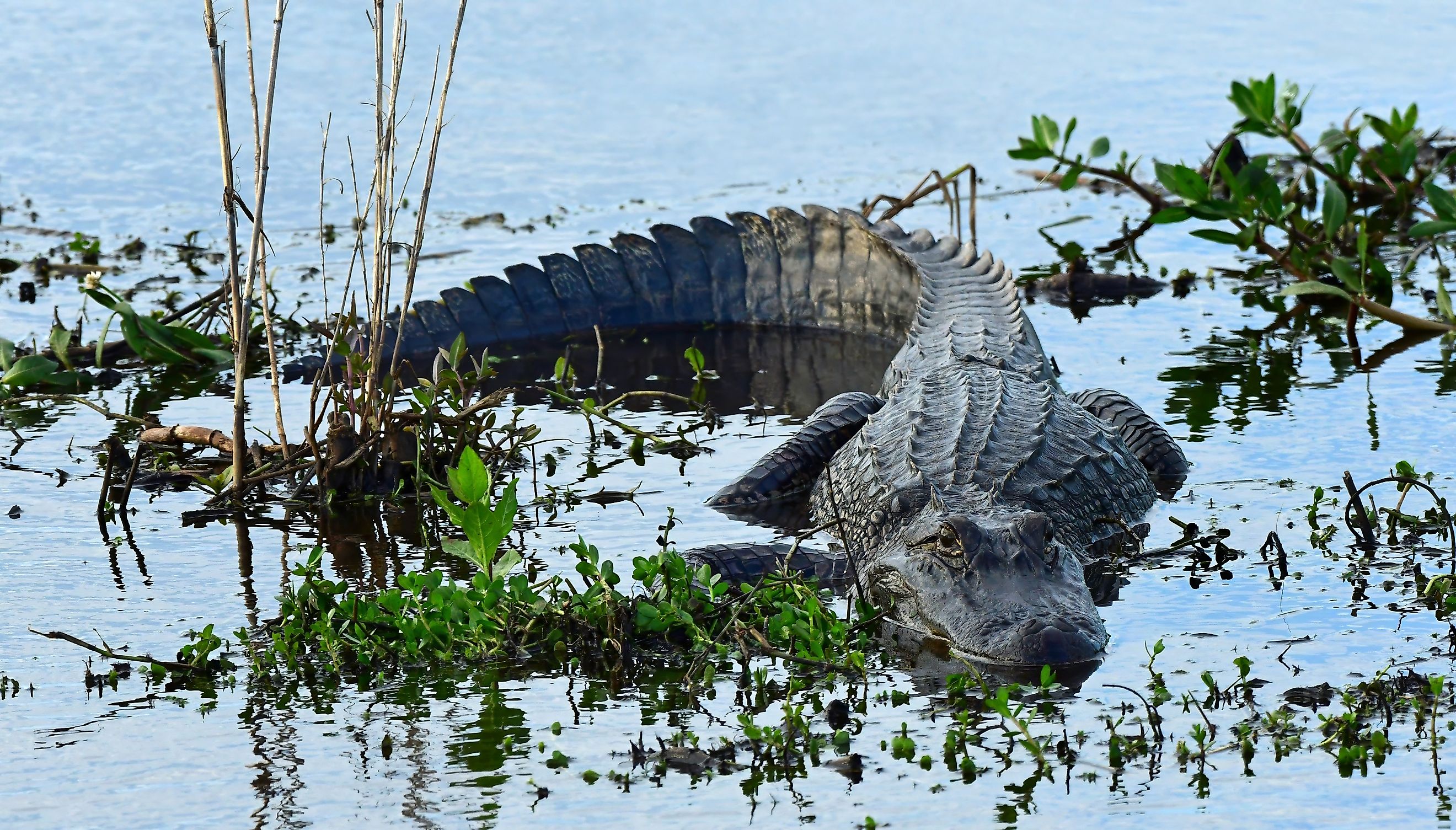
The 10 Deadliest Animals in Louisiana
The US state of Louisiana—nicknamed the Pelican State—is bordered by Arkansas, Mississippi, Texas, and the Gulf of Mexico. The 18th US state is made up of 3 geographic regions with distinct environments. From the wetlands to the sandy beaches, Louisiana's subtropical climate hosts a range of diverse wildlife.
Coyotes, muskrats, and the brown pelican call the state home. Among these animals, Louisiana also has a collection of dangerous animals. Louisiana's deadly animals come in all sizes, from the tiny brown widow spider to the mighty American alligator.
Brown Widow Spider
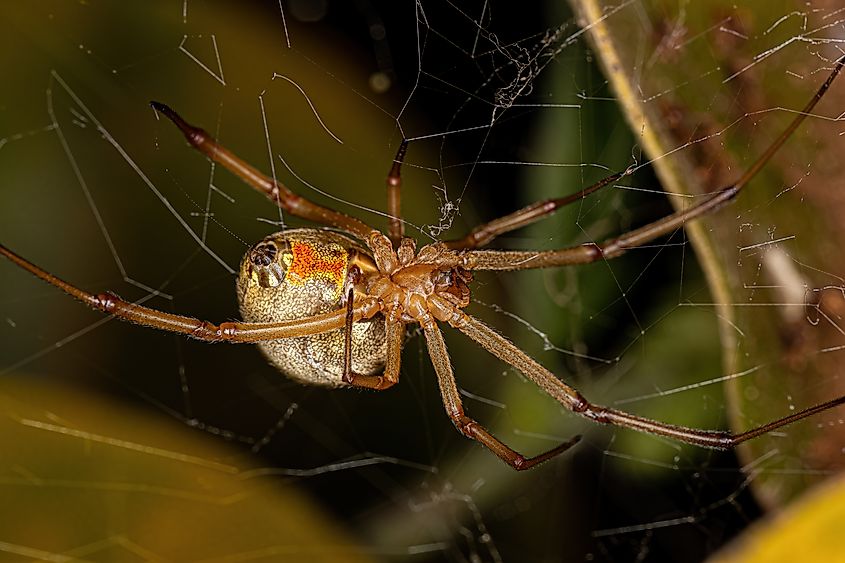
Also known as Latrodectus geometricus, brown widow spiders are not native to the US but are thought to originate in South Africa. Reportedly, this spider appeared in Louisiana sometime around the early 2000s, and by 2005, it was considered the most common widow spider distributed in certain urban areas in the state. In the US, brown widow spiders have been found from Texas to Georgia but are also present in some Caribbean Islands, as well as parts of Japan, Cyprus, and Australia.
Brown widow spiders typically live in large populations in and around homes or buildings, preferring to build their webs in secluded spaces like buckets, nursery pots, storage closets, and garages. Female brown widow spiders have more notable traits than their male counterparts, especially with their globular abdomens and vibrant orange-yellow marking (underneath the abdomen).
A bite from a brown widow spider is extremely rare and usually happens when a female is accidentally trapped. Though its bite is less venomous than other widow species, it can still hurt and may leave a red mark. To avoid bites from a brown widow, clean up clutter in residential spaces and seal up any holes or crevices.
Lionfish
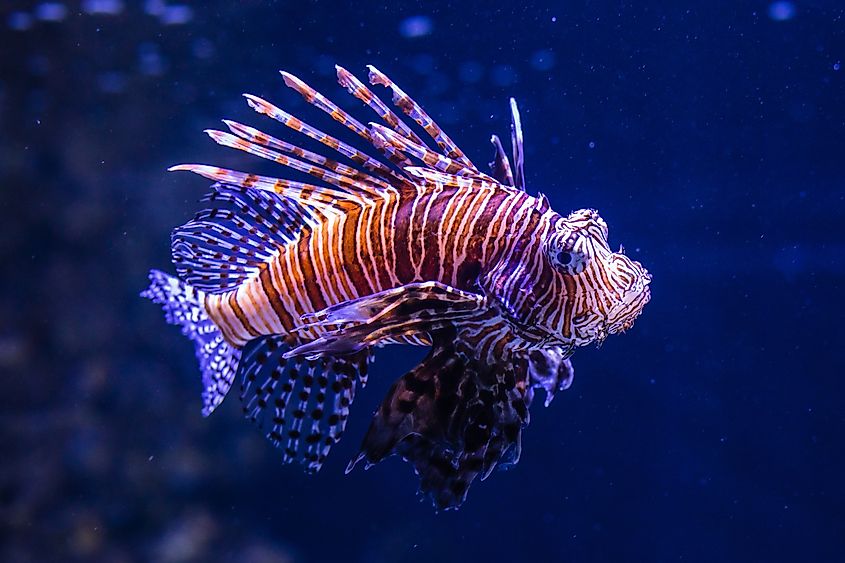
The lionfish (Pterois volitans or Pterois miles) is a venomous fish species native to the Indo-Pacific and Red Sea but has been sighted along the coasts of Alabama, Mississippi, and Louisiana, as well as the Gulf of Mexico. Lionfish sport 18 poisonous spines in 3 fin locations and can be brown or maroon with white bands along their body.
Lionfish are considered an invasive species. These colorful fish are indiscriminate eaters. They consume small fish and commercially important fish like snapper and grouper, which alters the ecological balance of the reef systems and impacts local fisheries.
Despite their allure, lionfish can pack a venomous sting, which can be painful for humans and potential predators! Luckily, lionfish prefer to avoid and flee from humans when they feel threatened. A lionfish sting is likely not fatal but may cause side effects like blistering and swelling. In severe cases, extreme side effects from the sting also include severe allergic reactions, shock, necrosis, and infection.
Buck Moth Caterpillar
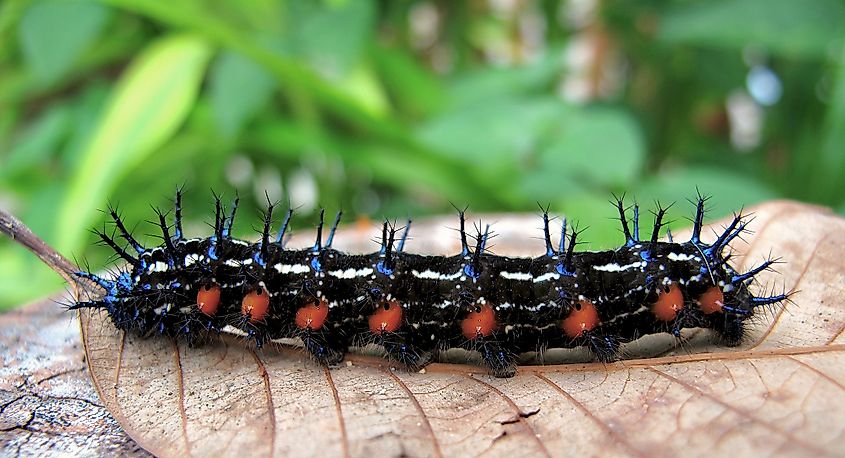
Buck moth (Hemileuca maia) caterpillars are native to the eastern US and known for their distinguished network of branched spines and white speckles across their black body. These caterpillars are typically found during the early summer and emerge as buck moths in the fall, donning prominent eye-like markings and white bands across their wings.
The buck moth caterpillar is far from harmless, as their branched spines connect to venom glands. Similar to a bee sting, its poisonous sting is immediately followed by a painful sensation, as well as swelling, itching, and redness around the area. Nausea may also develop in a victim within the first few hours of the bite.
The pain from a buck moth caterpillar bite can remain with a victim for over 24 hours, and allergic reactions to the bite have been reported. Bites from a buck moth caterpillar should be cleaned with soap and water (or a sterilizing agent), and medical attention should be sought if you suspect an allergic reaction to the buck moth caterpillar bite.
Brown Recluse Spider
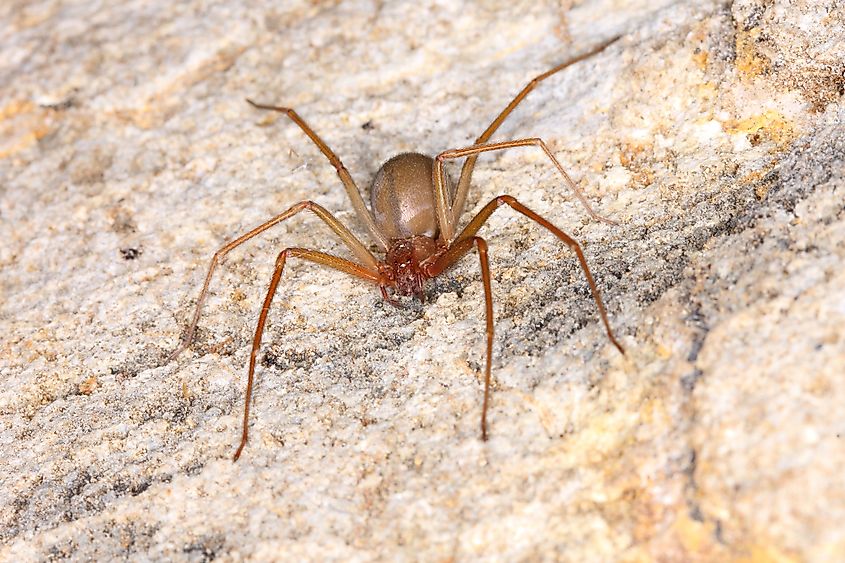
Brown recluse spiders are common in the northern part of Louisiana and typically thrive in dry, secluded places in small, isolated populations, from basement dwellings to creaky attics. Scientifically referred to as the Loxosceles reclusa, brown recluse spiders are noted for their violin-shaped markings on their dorsum. These small spiders are found from California to Virginia and are even present as far north as Nebraska, Illinois, Indiana, and Ohio.
Bites from a brown recluse spider are often accidental and usually happen when the spider is trapped against its victim's skin. These bites will often heal spontaneously without medical attention, though in rare cases, they have triggered localized skin necrosis and other unfortunate symptoms like headaches, body aches, rashes, fever, nausea, or vomiting. Luckily, brown recluse spiders are non-aggressive and shy, preferring to retreat to their lairs when they feel threatened.
Apple Snail
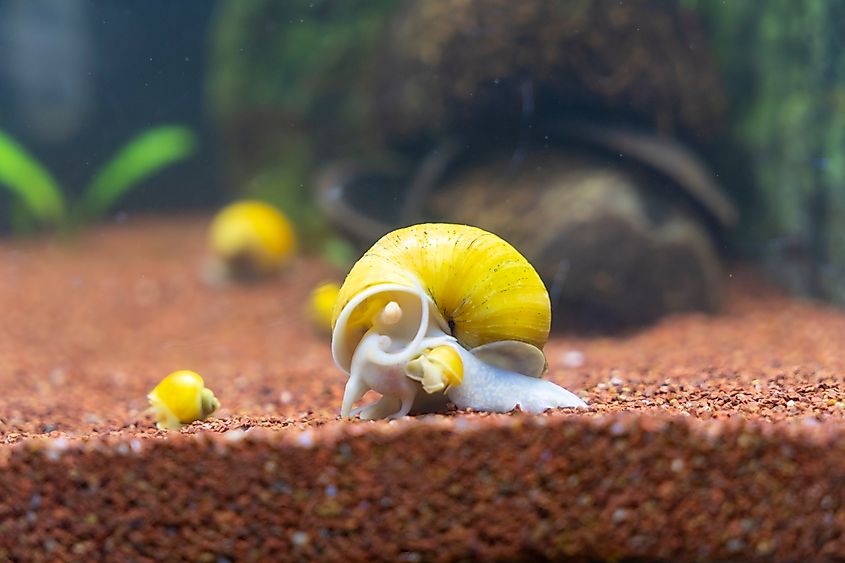
Also known as the giant apple snail or Pomacea maculata, the apple snail is a freshwater creature non-native to Louisiana. Native to South America, it is believed that this snail was introduced to the US by way of irresponsible aquarium dumping. In Southern Louisiana, apple snails thrive in freshwater lakes, rivers, marshes, ditches, ponds, and streams.
An apple snail's presence in a habitat is apparent with its bright pink egg masses on the surfaces of boats, crawfish traps, irrigation structures, or water bodies. The snails themselves have a golden yellow to brown shell with dark banding.
They are considered invasive species due to their rigorous consumption of aquatic vegetation and are also capable of infesting rice and crawfish ponds, altering the local aquatic environment.
Despite its size, apple snails are a host of rat lungworms. This parasite can infect humans through contaminated produce or undercooked snail meat. These snails also produce egg clusters that may carry a neurotoxin that's irritating to the eyes and skin in humans. Avoid handling apple snail eggs, and thoroughly wash your hands after handling the snails themselves.
Eastern Copperhead Snake
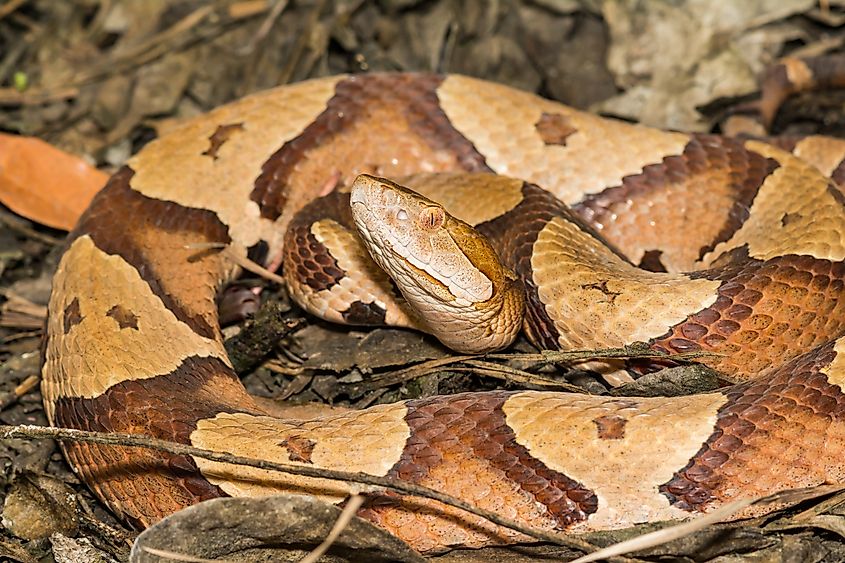
Known as the Agkistrodon contortrix, eastern copperhead snakes are endemic species to eastern North America. These snakes are pit vipers, sporting dark brown hourglass-shaped crossbands across a body that is usually beige, tan, or pale gray.
These venomous snakes of the United States prefer deciduous forest and mixed woodland environments. In Louisiana, eastern copperhead snakes live in woody and forested areas.
An eastern copperhead snake is not aggressive but may lie motionless and camouflage when it encounters a potential threat. Bites from eastern copperhead snakes often occur when humans unknowingly step on them or are near them. Despite their venomous reputation, their bites are rarely fatal but may cause side effects like extreme pain, tingling, throbbing, swelling, or nausea.
Texas Coral Snake
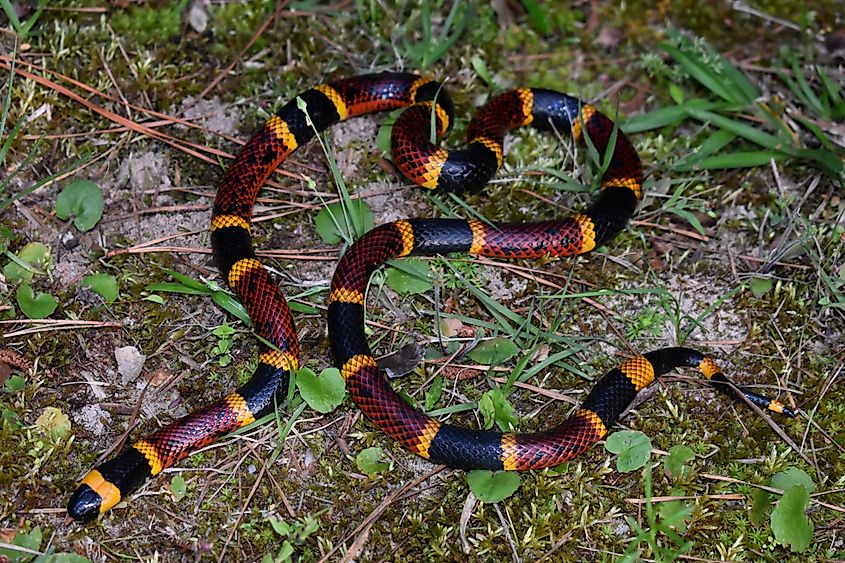
The Texas coral snake (Micrurus tener) is a poisonous snake endemic to the southern US and in northeastern and central Mexico. In Louisiana, the Texas coral snake's range spans the southwest and central parts of the state. They can be found living among the vegetation across rivers, streams, and creeks, as well as deserts, forests, woodlands, grasslands, savanna, and shrubland habitats.
This venomous snake contains smooth dorsal scales, a round head, and black, yellow, and red bands across its body. The Texas coral snake is commonly mistaken for non-venomous species like the Louisiana milk snake, scarlet snake, and mud snake. It is important to remember that in Louisiana and Texas, coral snakes generally have dark red bands (with some speckles of black) sandwiched between two thin yellow rings. Their heads sport a black nose and eyes, with a broad yellow band on its head.
Habitually, Texas coral snakes are shy, secretive, and solitary. That does not mean their bite should not be underestimated—the venom from this snake is a powerful neurotoxin. Fatal bites from this snake are rare but are capable of causing neuromuscular dysfunction.
Pygmy Rattlesnake
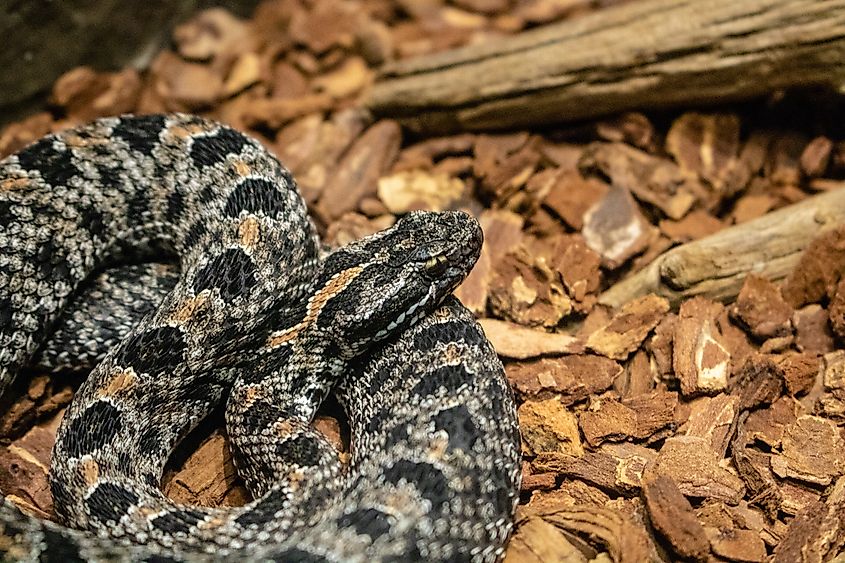
The pygmy rattlesnake (Sistrurus milarius) is Louisiana's small poisonous rattlesnake and the smallest in the US. with adults reaching sizes of between 11 to 20 inches. They are found across Louisiana, preferring wooded areas, and areas with a grass understory like pinelands or dry coastlands.
These small snakes have patterns of tan, black, and grey blotches and bands across its body. The pygmy rattlesnake also has a small rattle on the tip of its black tail. Pygmy rattlesnakes are rarely spotted by humans and prefer to stay hidden, relying on their camouflage.
Pygmy rattlesnakes will strike if they are disturbed to defend themselves. Fortunately, due to their size, their bite is not as serious compared to their relatives. While their bite is unlikely fatal, the venom it carries is still hemotoxic and may cause pain and swelling.
Eastern Diamondback Rattlesnake
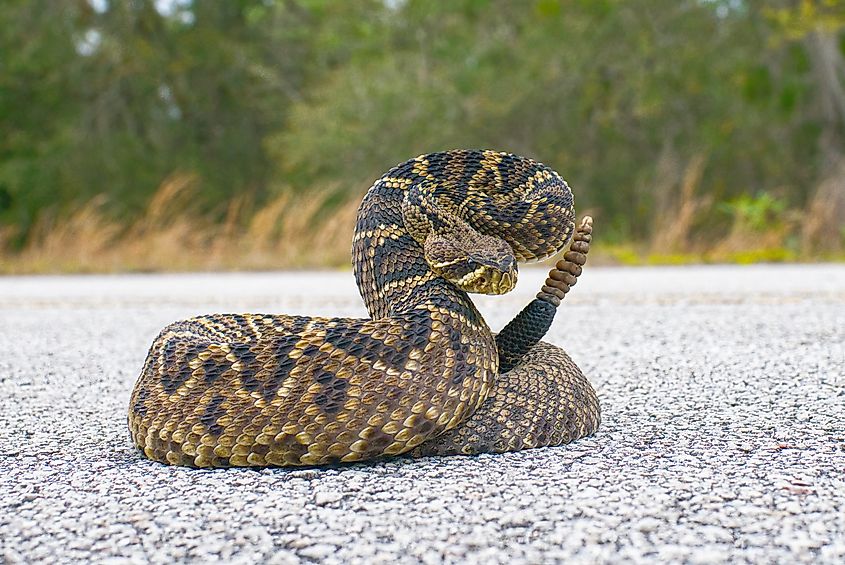
The Eastern diamondback rattlesnake (Crotalus adamenteus) is the largest in the world, with adult snakes commonly spanning 4 to 5 feet long! An Eastern diamondback rattlesnake has distinguishable traits that include a dorsal diamond pattern that is dark brown with pale edges, a yellow and unpatterned stomach, and a dark tail with a rattle.
This rattlesnake is an elusive reptile, yet packs a bite with venom that is capable of destroying red blood cells.
Eastern diamondback rattlesnakes are found in North Carolina, South Carolina, Georgia, Alabama, Mississippi, and Florida. It is likely that these rattlesnakes are no longer present in Louisiana and have been extirpated from habitat loss due to agricultural expansion and urbanization. However, their presence has been reported in the state, with the most recent record reported near Franklinton in 1995.
American Alligator
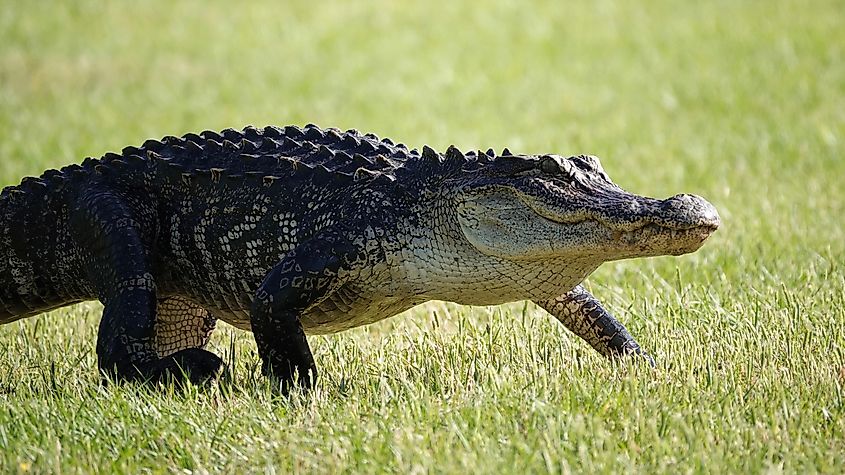
The American alligator (Alligator mississippiensis) is revered as the largest reptile in North America. This native North American reptile is equipped with short and thick appendages suitable for swimming and a powerful tail capable of breaking its prey's legs. The American alligator also has a round snout, which is distinguishable from the pointed crocodile snout. There are estimated to be over 2 million crocodiles in Louisana that are often found in ponds, lakes, canals, bayous, rivers, and swamps!
American alligators are territorial and motile animals but are known to retreat from humans when they hear the sounds of boats or intruders. Do not underestimate these cold-blooded animals; American alligators can pack a punch with their powerful tail and are large reptiles that can weigh over 500 lbs! These powerful reptiles should not be harassed, approached, challenged, or fed. Alligator attacks are rare but have occurred while people are swimming or disrupting their natural habitat.
Louisiana’s Diverse and Dangerous Wildlife: A Closer Look
Louisiana's subtropical climate supports a melange of wildlife, from the humid wetlands to the sandy beaches. Among the state's population of coyotes and brown pelicans, Louisiana has its share of deadly animals. Louisana's deadly animals come in all sizes and are each equipped with unique defense mechanisms, from the tiny brown widow spider to the mighty American alligator.











